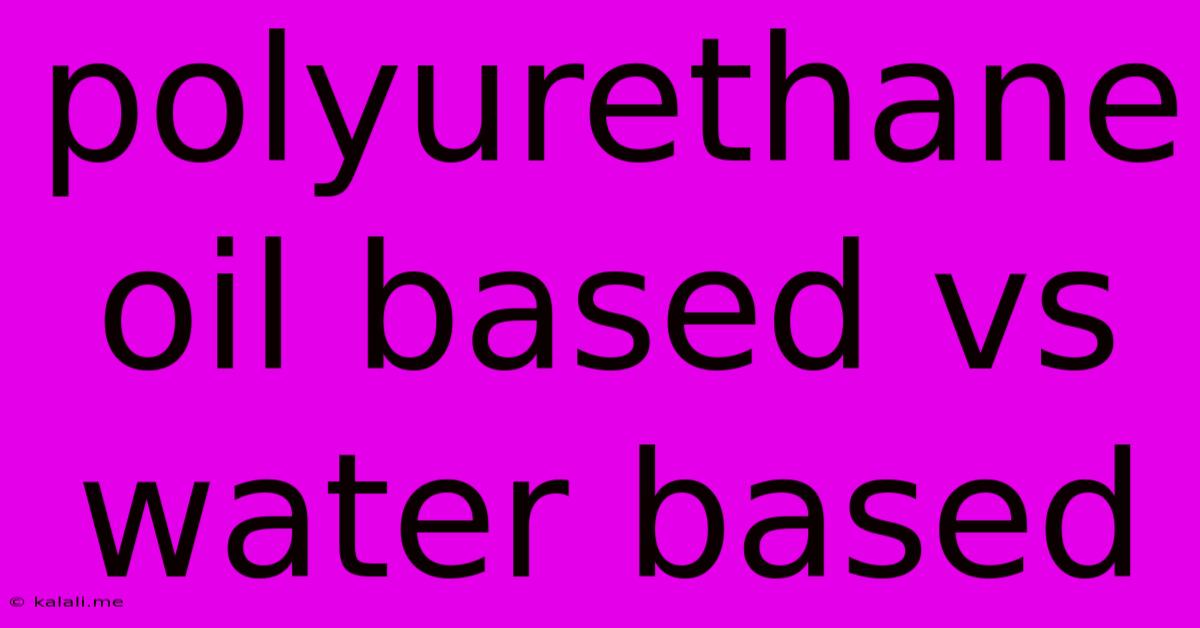Polyurethane Oil Based Vs Water Based
Kalali
Jun 01, 2025 · 3 min read

Table of Contents
Polyurethane Oil-Based vs. Water-Based: Choosing the Right Finish for Your Project
Choosing between oil-based and water-based polyurethane can feel overwhelming. Both offer durable protection for wood, but their application, drying time, and final finish differ significantly. This guide breaks down the key differences to help you select the best polyurethane for your project. Understanding these distinctions will ensure a smooth, professional-looking finish every time.
Key Differences: A Quick Overview
| Feature | Oil-Based Polyurethane | Water-Based Polyurethane |
|---|---|---|
| Drying Time | Much longer (several hours to days) | Much faster (a few hours) |
| Cleanup | Requires mineral spirits or paint thinner | Cleans up with soap and water |
| Durability | Generally more durable, especially for high-traffic areas | Very durable, improvements in recent years |
| VOCs | Higher volatile organic compounds (VOCs) | Lower VOCs, more environmentally friendly |
| Finish Appearance | Often produces a warmer, richer tone | Can sometimes appear slightly less warm, more modern |
| Cost | Generally more expensive | Generally less expensive |
Oil-Based Polyurethane: The Traditional Choice
Oil-based polyurethane has been a woodworking staple for decades. Its reputation for superior durability, especially on floors and furniture that see heavy use, is well-deserved. The amber tint it imparts adds a warm, classic look to wood.
Pros:
- Exceptional Durability: Resists scratches, dents, and wear better than water-based options, particularly in high-traffic areas.
- Rich, Warm Finish: The amber tone enhances the natural beauty of wood.
- Self-Leveling Properties: Often provides a smoother, self-leveling finish.
Cons:
- Long Drying Time: Requires significantly longer drying time between coats, extending the project timeline.
- Strong Odor: Produces strong fumes during application and drying, requiring good ventilation.
- Difficult Cleanup: Requires solvents like mineral spirits or paint thinner for cleanup, adding complexity and disposal concerns.
- Yellowing Over Time: Can yellow over time, especially in direct sunlight.
Water-Based Polyurethane: The Modern Alternative
Water-based polyurethane has gained immense popularity due to its ease of use and environmental friendliness. Modern formulations offer durability that rivals oil-based alternatives, making it a suitable choice for many projects.
Pros:
- Fast Drying Time: Dries much faster than oil-based polyurethane, allowing for quicker project completion.
- Easy Cleanup: Cleans up easily with soap and water.
- Low VOCs: Environmentally friendly with significantly lower VOC emissions.
- Less Odor: Produces less odor compared to oil-based polyurethane.
Cons:
- Slightly Less Durable (Historically): While modern formulations are highly durable, it was traditionally considered less durable than oil-based polyurethane for high-traffic areas. However, this gap is narrowing considerably.
- Can Raise the Grain: Might raise the wood grain slightly, requiring sanding before applying subsequent coats.
- May Not Self-Level as Well: Can require more careful application to achieve a perfectly smooth finish.
Choosing the Right Polyurethane: Consider Your Project
The best polyurethane depends entirely on your specific needs and preferences.
- High-traffic areas (floors, tables): Oil-based polyurethane offers superior durability and scratch resistance.
- Furniture, cabinets, less trafficked areas: Water-based polyurethane offers a great balance of durability and ease of use.
- Environmental concerns: Water-based polyurethane is the clear winner due to its low VOC content.
- Time constraints: Water-based polyurethane's faster drying time is a significant advantage.
- Desired finish: Oil-based provides a richer, warmer tone. Water-based tends to maintain the wood's natural color more closely.
Ultimately, understanding the strengths and weaknesses of both oil-based and water-based polyurethanes empowers you to make an informed decision that aligns perfectly with your project's requirements and your personal preferences. Don't be afraid to experiment and find the finish that best suits your skills and aesthetic vision.
Latest Posts
Latest Posts
-
15 Amp Outlet On 20 Amp Breaker
Jun 02, 2025
-
How To Find Basis For Null Space
Jun 02, 2025
-
How To Fix Curtain Rod Falling Out Of Wall
Jun 02, 2025
-
The Bird Flew At 20 Mph S
Jun 02, 2025
-
Why Did Ruth Uncover His Feet
Jun 02, 2025
Related Post
Thank you for visiting our website which covers about Polyurethane Oil Based Vs Water Based . We hope the information provided has been useful to you. Feel free to contact us if you have any questions or need further assistance. See you next time and don't miss to bookmark.